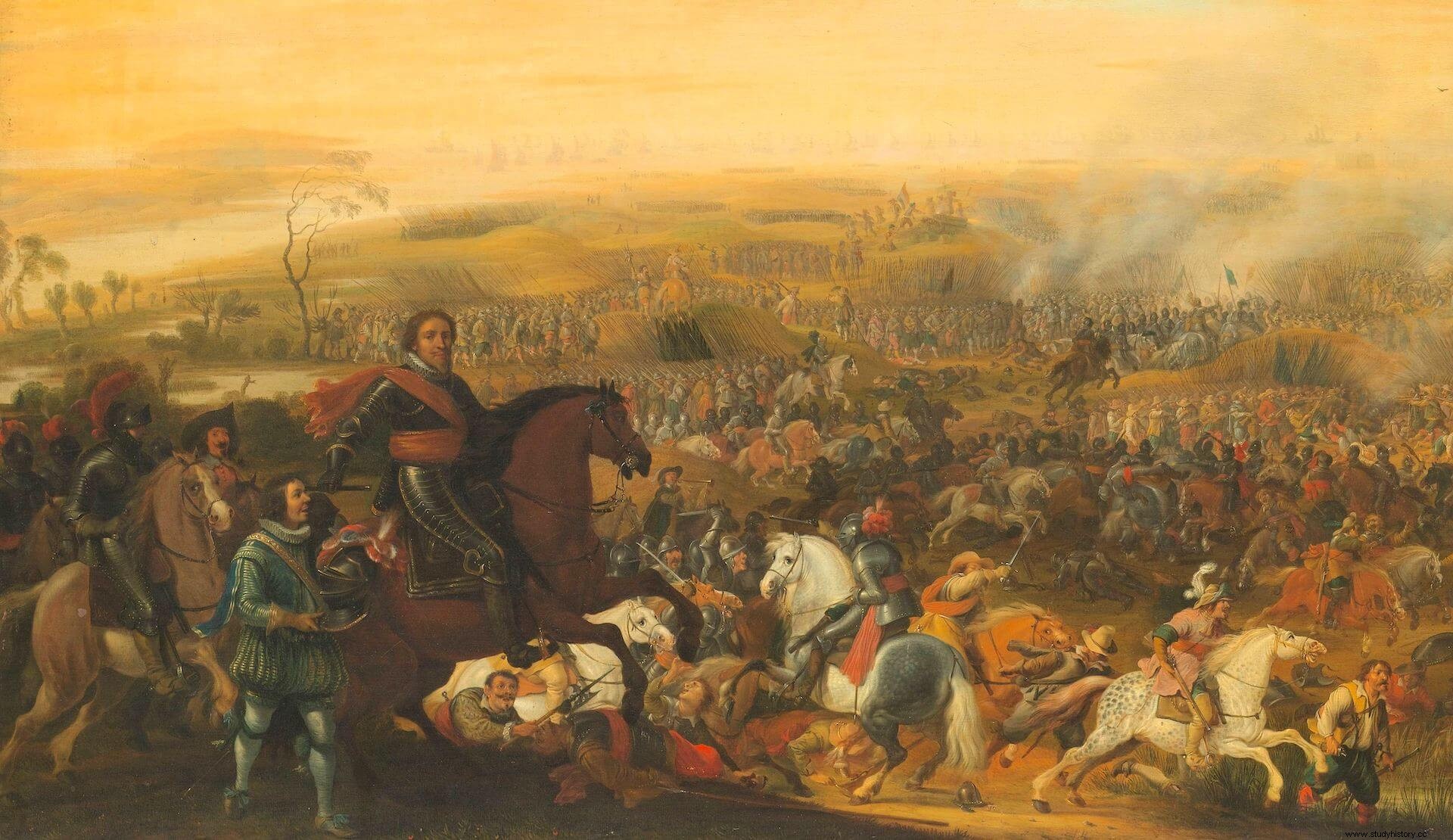
Unlike the first half of the 16th century, the decline in pitched battles in favor of sieges, coups, skirmishes, and other minor operations fundamentally affected combat between infantry formations, despite which, as we shall see, the pike continued to retain an important role. transcendental in all the armies of the period.
Reborn Chivalry
The main tactical innovations of the time were the adoption of the musket, which will be discussed later, and the arrival on the battlefields on a massive scale of equipped cavalry with firearms . We find different denominations for this type of troop:reiters , herreruelos, harquebusiers on horseback, argolets and garabies . The Germans were well armored and, according to Bernardino de Mendoza:"they wear breastplates and backrests, and some of them have black helmets, and two pistols hanging from the frame of the saddle with which they fight, which are small arquebuses."[1] To the argolets On the other hand, the Huguenot military man Théodore Agrippa d'Aubigné describes them as "cavalerie legere" and "armez à la legere", and assimilates them to the estradiotes.[2] In 1575, the chronicler Jean Le Frère wrote about "estradiotes, argolets and arquebusiers on horseback that the diversity of times, places and necessity have brought us."[3]
This varied cavalry equipped with firearms began to gain prominence in the 1540s and proved their worth at the Battle of San Quentin , in which the German herreruelos in the service of Felipe II broke the infantry of the French army. This was explained by a Gallic officer in a letter he wrote in Paris on August 13, 1557, three days after the clash:

Contrary to what has been maintained, the Herreruelos did not come to replace the knights armed with lances, but to complement them to break a much better cohesive infantry than at the end of the 15th century. The usefulness of this practice was made clear in Mühlberg (1547), where the imperial cavalry destroyed the army of Duke John George of Saxony with hardly any intervention from their own infantry. Luis de Ávila y Zúñiga, war adviser to Charles V and a witness to the battle, explains that the imperial cavalry squadrons and those of King Ferdinand of Hungary, the emperor's brother, combined spears or helmets, that is, knights in full armor and armed with lances at the ready –or rather Hungarian hussars–, and blacksmiths and harquebusiers on horseback:
The soldier Diego Núñez Alba, who fought in the battle, explains that not only the well-cohesive imperial cavalry swept away the Saxons, but also the enemy Lansquenets in a brutal melee to body:
Bernardino de Mendoza, one of the most outstanding cavalry commanders of the Duke of Alba and architect of the Spanish triumph at the Battle of Mookerheide (1574), would advise combining both types of cavalry as follows way in the treaty Theory and practice of war :“Having spears and blacksmiths in the army, it is a very good way to mix them [to] place a bugle of blacksmiths on the left side of the spears, which serves as a sleeve, which has to close shortly before the spears, because their company is of effect and benefit and the gunmen do it, giving their spray, as they are used to when charging, in the shape of a crescent.”[7] This was the best way to use the herreruelos and harquebusiers on horseback, as mouths of fire for the spear squads, and not independently, when they fought following the conch tactic , which consisted of shooting in circles against the enemy formation without reaching melee.
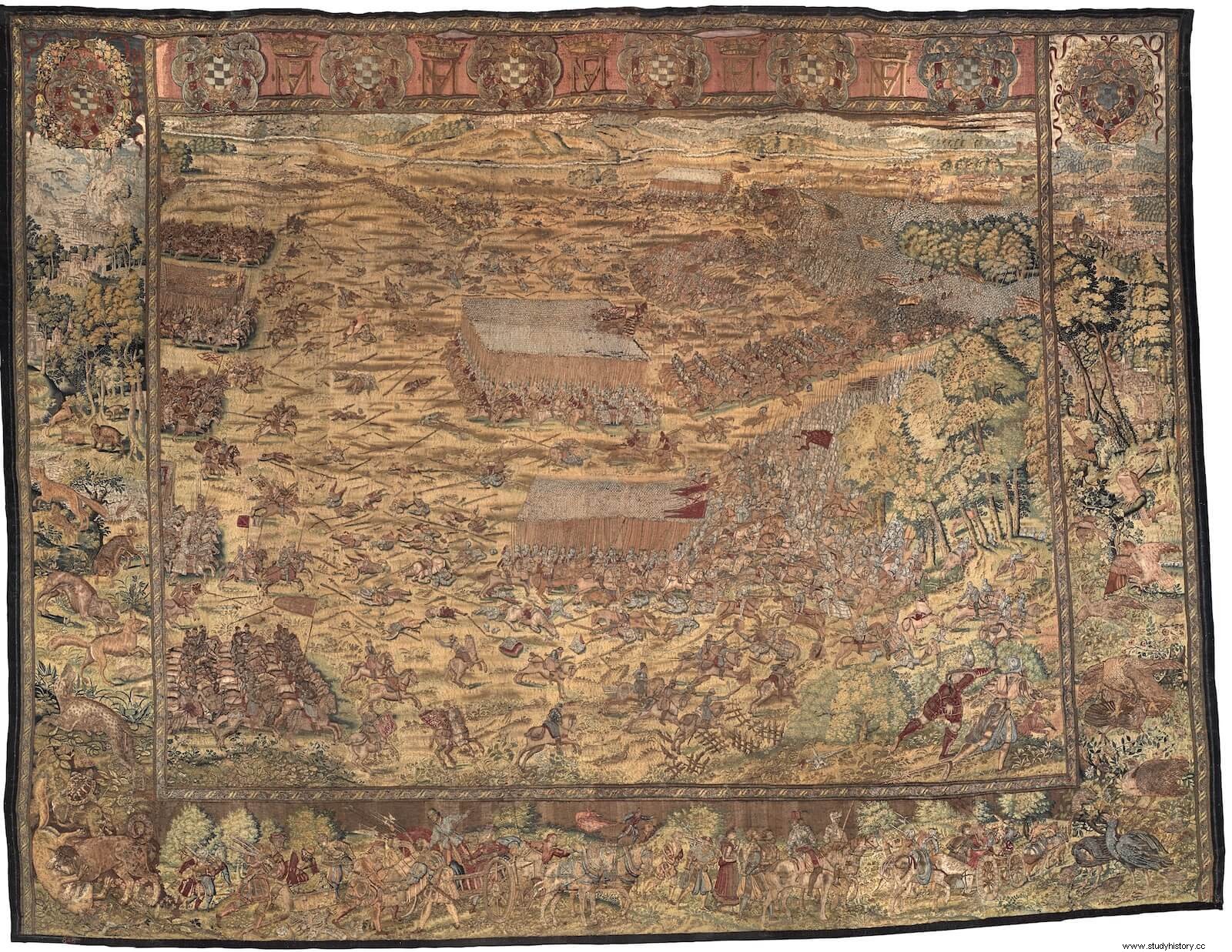
Among theorists of the time there was a broad consensus around the primacy of shock over ranged combat, whether cavalry was attacking other mounted troops or infantry. The Huguenot François de la Noue emerged as a firm detractor of the conch due to his bad experiences in various combats of the Wars of Religion . In his Discours politiques et militaires (1588), described the conch shell as "an unfortunate invention more suited to the game of bars than to combat", to then describe its main problems, namely, that the troops marching behind often interpreted the conch shell the herreruelos as a flight and broke ranks in terror, and that in general only the men in the first ranks were targeted, since the others fired into the air, without forgetting that "those who have directed them did not remember that the pistol almost did not has an effect if not fired at three steps, and that the [enemy] troops will not break if they are not attacked with force.”[8] The opinion of the opponent of the Catholic Jean de Saulx-Tavannes was not much better:“The French, organized in squads in the same way, have reached the advantage over the reiters that caracolean without reaching the shock. Rushing them as they turn and are in disarray, the French have run over them with little resistance.”[9]
The battles of the second half of the 16th century show that the cavalry recovered some of the importance it had lost in the first third of the century, in which it went from constituting two thirds parts of the armies in 1494 to barely one eleventh in 1528.[10] The proliferation of wheellock pistols and arquebuses, which worked without the need for fuses, had something to do with it, since, if we follow Saulx-Tavannes, he diverted the German nobility from infantry to mounted weapons:“All nobility German used to fight on foot, and received the name of lansquenetes, which means servants of the country; since the invention of pistols in the war of Charles V [the War of the Schmalkaldic League, 1546-1547], they ride horses, and there are only the bourgeois and peasants in the infantry.”[11] Precisely, in his Relazione di Francia (1572), the Venetian ambassador to the court of Charles IX, Alvise Contarini, communicated to the Venetian senate that:"something worthy of note is this that we have noticed in this war of the kingdom of France, namely that, if in a few years the French infantry has improved and cavalry has worsened, just the opposite has happened in German infantry and cavalry.”[12]
The infantry in the French War of Religion
The bloody confessional and civil conflicts that shook France after the death of Henry II, in 1559, until the last years of the century, were characterized by the dominance of the cavalry on the tactical level . The reasons were diverse:the size of the country and its lack of modern fortifications; the tradition of the French nobility to fight on horseback; the practice, common since the 1540s, of interspersing infantry and cavalry squads, which gave greater versatility to the mounted weapon than if it were limited to fighting on the flanks of the army, and the very nature of the conflict, characterized not by great sieges and battles –although there were–, but, rather, by small-scale operations.[13]
In this context there was a growing specialization among infantry units , closely linked to their team and nationality. In his study of the conflict, James B. Wood identifies units with an overwhelming proportion of pikes—such as Pfyffer's Swiss Regiment, with 87% pikemen and 13% firearms; units with a proportional number of pikemen and arquebusiers – the French infantry “gangs” – and units with an overwhelming ratio of muzzles to pikes – for example, the Italian “gangs” recruited in 1567 by the Duke of Nevers, with 10% pikes and 90% arquebuses–.[14] Units with a higher proportion of pikes were more useful for battles and raids, while those that prioritized firearms were more useful for skirmishes and coups. In general, among the theoreticians of the time, the pike enjoyed more renown than the arquebus. François de la Noue, without going any further, wrote that “the arquebus is conducive to instructing young people. When they have gained reputation and experience, it is convenient to place them in the other rank [the pike], which must be considered as honorable or more honorable than the first.”[15] In 1562, Armand de Gontaut, Baron de Biron, was of the opinion that the pike was essential:
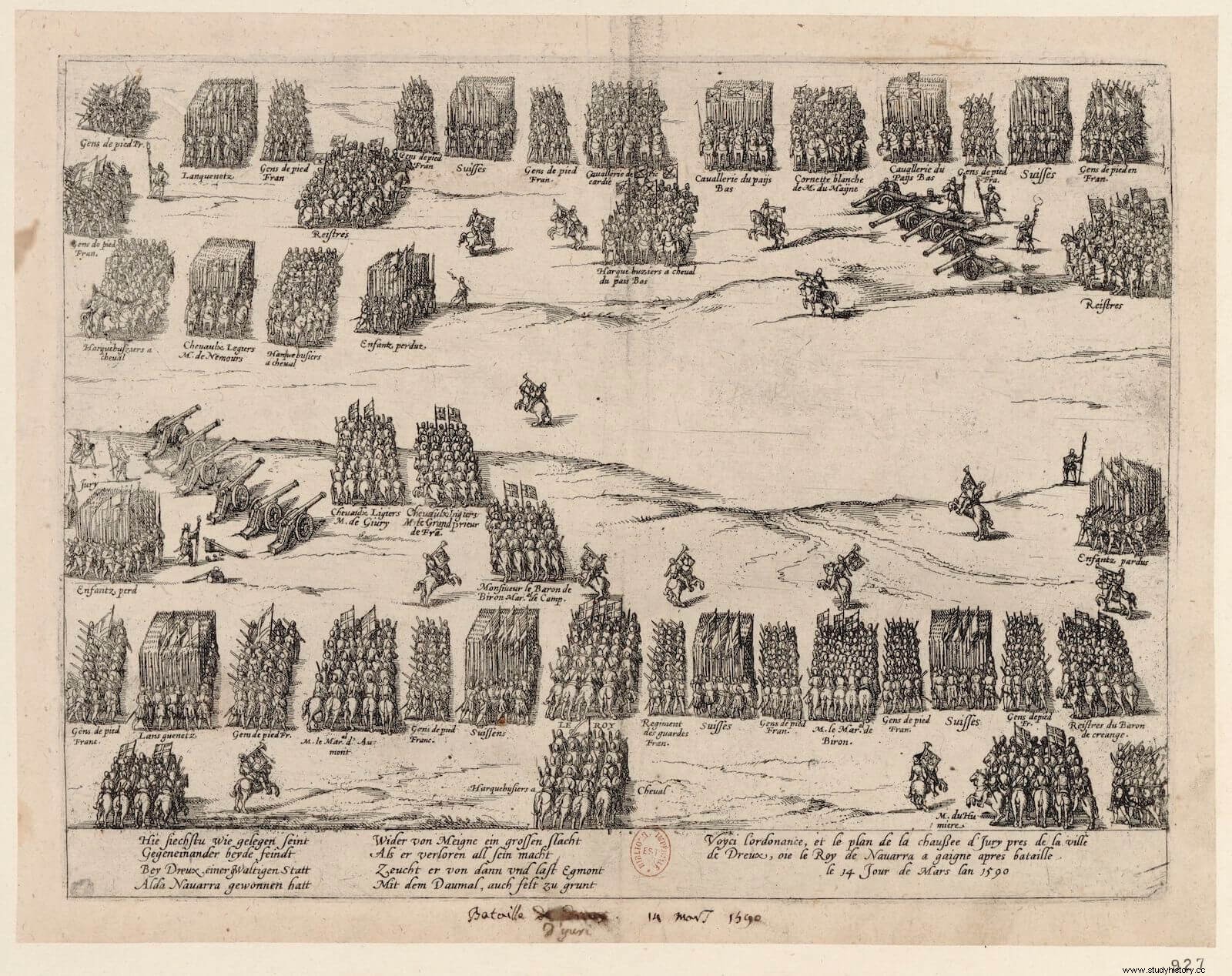
In the same way as in the armies of the Hispanic Monarchy was common to form squadrons of mixed nationalities, in general of German pikemen and Spanish arquebusiers, in the French Catholic and Protestant forces would be combined during the wars of religion Swiss or German pikemen and French arquebusiers. Frans Hogenberg's engraving of the Ivry order of battle (1590) is revealing in this regard. With this, the infantry gained versatility against any kind of troops. Saulx-Tavannes describes how the pikemen had to fight against cavalry and other pike formations, since the way of holding the pike and ordering the first ranks of the squad varied depending on the type of enemy:
The new versatility of cavalry, both through its adoption of the firearm and the practice of interspersing it between infantry squads, posed a double risk for squads with few pikes . According to De la Noue:"If they do not have pikes or discipline, I have no doubt that ten thousand arquebusiers would never dare to show themselves on the plain with only six hundred lances."[18] In the opinion of Marshal Biron:“if some well-chosen lansquenets march in large numbers, as is their custom, with French arquebusiers, there is no city or town that can resist them.”[19]
In the battles of the French Wars of Religion, the offensive role fell, above all, to the cavalry, which does not mean that combats between infantry formations were common, and that were almost always resolved in the clash of spades . The first general confrontation, which took place at Dreux (1562), offers two magnificent examples showing that, although in the minds of both commanders – the Catholic Montmorency and the Protestant Condé – the key was cavalry, the victor used to rise. with the triumph thanks to his foot troops. In this battle, Montmorency was captured at the head of his cavalry in the first Protestant charge, in which Admiral Gaspard de Coligny, commanding the Huguenot vanguard, broke with his cavalry the men-at-arms and the Catholic light cavalry, in addition to the infantry regiments of Brittany and Picardy. The core of the Catholic center was a Swiss squadron of 5,000 men – 22 or 29 companies, according to sources – occupying a 500m front and tasked with protecting eight artillery pieces.[20] Against them Condé charged at the command of 900 men-at-arms, 800 reiters and 200 argolets . The Huguenot Jean de Mergey describes the formidable sight:"We met their Swiss at the head, who barred our way, and threw some charges at them, but it was difficult to break such hedgehogs, and this was partly the cause of our defeat.”[21] The crash was extremely violent and the Swiss squad came close to breaking up. In the words of the Duke of Guise, second in command of the Catholic camp:
The Swiss lost three or four hundred men in this phase of the fighting, but held out, reformed their ranks and made a change of front to the left, parallel to the line of enemy advance. According to the Duc de Guise:“yet once more the [Protestant horsemen] drove them to the ground in great numbers two and three times, and their ranks were broken, though they were re-established as many times.”[23]
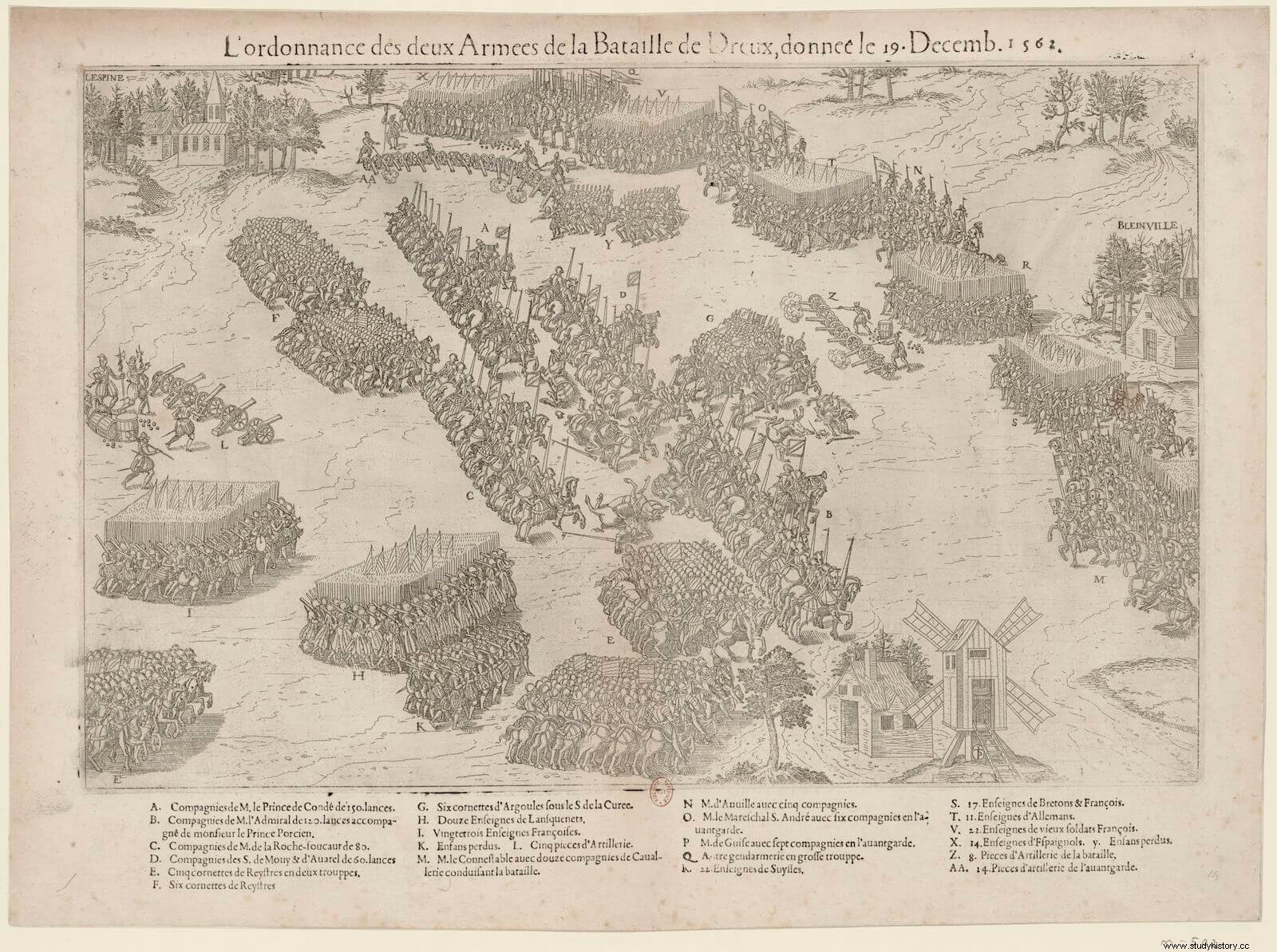
Tired of launching futile charges, the Huguenot cavalry left the Swiss behind him to plunder the Catholic camp while the Protestant infantry of the battle corps, made up of 2,000 lansquenets, commanded by Monsieur Andelot, and 5,000 French infantry, advanced to finish off the battered Swiss. By this time the squadron had suffered heavy losses, close to half its strength, including seventeen captains, but Colonel Pfyffer roused his men and went on the counterattack. A Catholic officer present, Michel de Castelnau, lord of the Mauvissière, wrote that "the Prince de Condé's lansquenets, who saw them assaulted from all sides, wanted to do their part, but the Swiss, seeing them, far from being frightened, marched straight towards them and put them to flight.”[24] For an entire cadre to break ranks without waiting for the onslaught of enemy infantry was unusual, hence Jean Le Frère writing in his war chronicle:“It is certain that in fifty years no more cowardly men than these had entered France, even though they had the best looks in the world.”[25]
The resistance of the Swiss, finally broken by a last Protestant charge, allowed the Duke of Guise, now in command of the royal forces, to operate a change of front and fight back. On this occasion, the leading role fell to the 1900 Spaniards under the command of Diego de Carvajal, governor of Fuenterrabía, who Philip II had sent to the aid of Charles IX. One of his captains, Juan de Ayala, wrote a detailed report on the battle that describes the Hispanic tactical device:
The Huguenot infantry did not run like the Lansquenets, but lost their nerve when the Spanish squadron reached the charging distance –15 m– and were overwhelmed and massacred. According to Ayala:
The Battle of Dreux demonstrated that while the cavalry had the initiative and played a clear offensive role,the infantry was the determining force . The resistance of the Swiss, whose proportion of pikes far exceeded what was common at the time, was the key to the Catholic victory, while the onslaught of the Spanish pikes on the Huguenot infantry decided the match. We find ourselves, once again, before a battle won by polearms. In the next great battle of the contest, that of Moncontour (1569), the Protestant army under the command of Gaspard de Coligny would be much more easily defeated by the royal army of the Duke of Alençon, who was advised by the experienced Tavannes. On this occasion, rejected the reiters Protestants by the volleys of Catholic arquebusiers entrenched behind a line of wagons, and then put to flight by royal cavalry, the role of the infantry was more limited; consisted of breaking and massacring its Huguenot counterpart.
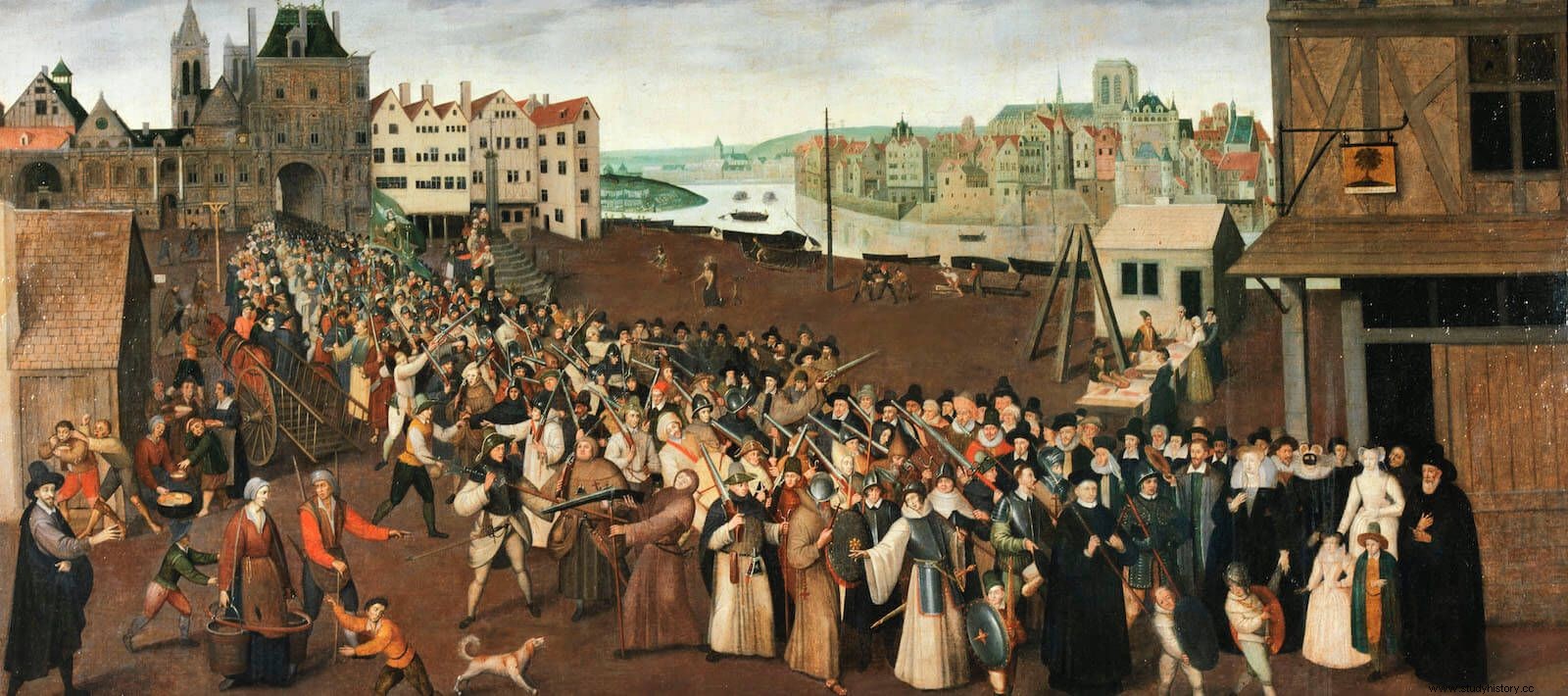
After Moncontour, the French Wars of Religion They were reduced to sieges, cavalry clashes and small-scale actions that did not involve fighting in battle order. The resumption of hostilities on a large scale, in 1585, sealed the primacy of the cavalry above the infantry. The preponderant military figure in this phase, Henry of Navarre –Henry IV of France–, in the words of Charles Oman:“undoubtedly belonged to the school of his uncle, the old Condé, and believed in winning battles by means of overwhelming charges of cavalry in which he himself would lead the decisive attack.”[28] At this point, the disagreement between the French and Spanish-Dutch military models worsened, which Jean de Saulx-Tavannes described with a historical simile:“it seems that the two kings have chosen to concentrate their main forces, one on the cavalry, which is the King of France, in imitation of the Parthians, and the King of Spain in the infantry, like the Roman legions; and they must be different in the battle orders, one so that their cavalry fights with advantage and the other so that their foot troops do it”.[29]
The battles of Henry of Navarre, Courtras (1587), Arques (1589) and Ivry (1590), were above all cavalry clashes. Only in Courtras did the infantry of both armies engage in a melee, an episode described by Théodore Agrippa d'Aubigné and which attests to the great improvement in the quality of the Huguenot infantrymen, whose arquebusiers managed to break, sword in hand, a tableau catholic spades:
The interest of the confrontation between Enrique de Navarra and Alejandro Farnesio lies in the contrast between their two tactical schools, so dissimilar that the expected great battle between the two greats of the moment did not take place , as the Italian always waited for the Gaul behind entrenched positions, while the latter did not dare to risk more than small portions of his army when he surprised the Army of Flanders in the open field.
The Flemish school of the Duke of Alba
The War of Flanders (1566-1648), was characterized by sieges and the operations that took place around them, such as attacks on convoys, relief efforts and raids on military bases. enemy supplies. Only a handful of actions can be considered true pitched battles between squadron armies:Heiligerlee (1568), Jemmingen (1568), Mookerheide (1574), Gembloux (1578), Noordhorn (1581), Steenbergen (1583), Turnhout (1597), and Nieuwpoort ( 1600). Only Gembloux was fought on a flat and open stage, while the others were affected by the rugged terrain of the Netherlands, with obstacles such as dunes, rivers, canals, swamps, dikes and forests, which limited the largely the action of the cavalry, especially in the northern provinces, furrowed by the innumerable river courses that formed the deltas of the Rhine and the Meuse. In the words of the Welshman Roger Williams, a mercenary in the pay of the rebels, there Alba “did not need much cavalry for the reason that it was certain that he would have little before him and because those terrains do not give rise to many horse troops fighting in them. ”.[31] Consequently, the infantry remained the main force.
In the middle of the 16th century, the tactical model of the Spanish infantry had undergone few variations with respect to the practice of the preceding decades. In 1552, on the occasion of the stay of the future Felipe II in Milan, a pitched battle between two squads was organized there, which perfectly illustrates the Spanish tactical model. Surgeon Joan Cristòfor Calvet d'Estrella, a witness to the exercise, describes it in detail. First there was the usual and inconclusive duel between the cannons of both armies:"with each squadron there were some small field artillery pieces with which the battle began, starting to play the artillery from one side to another."[32] Immediately there was a skirmish between groups of arquebusiers from both squadrons, which were covered by a handful of pikemen broken off from the square. Finally, there was the onslaught:
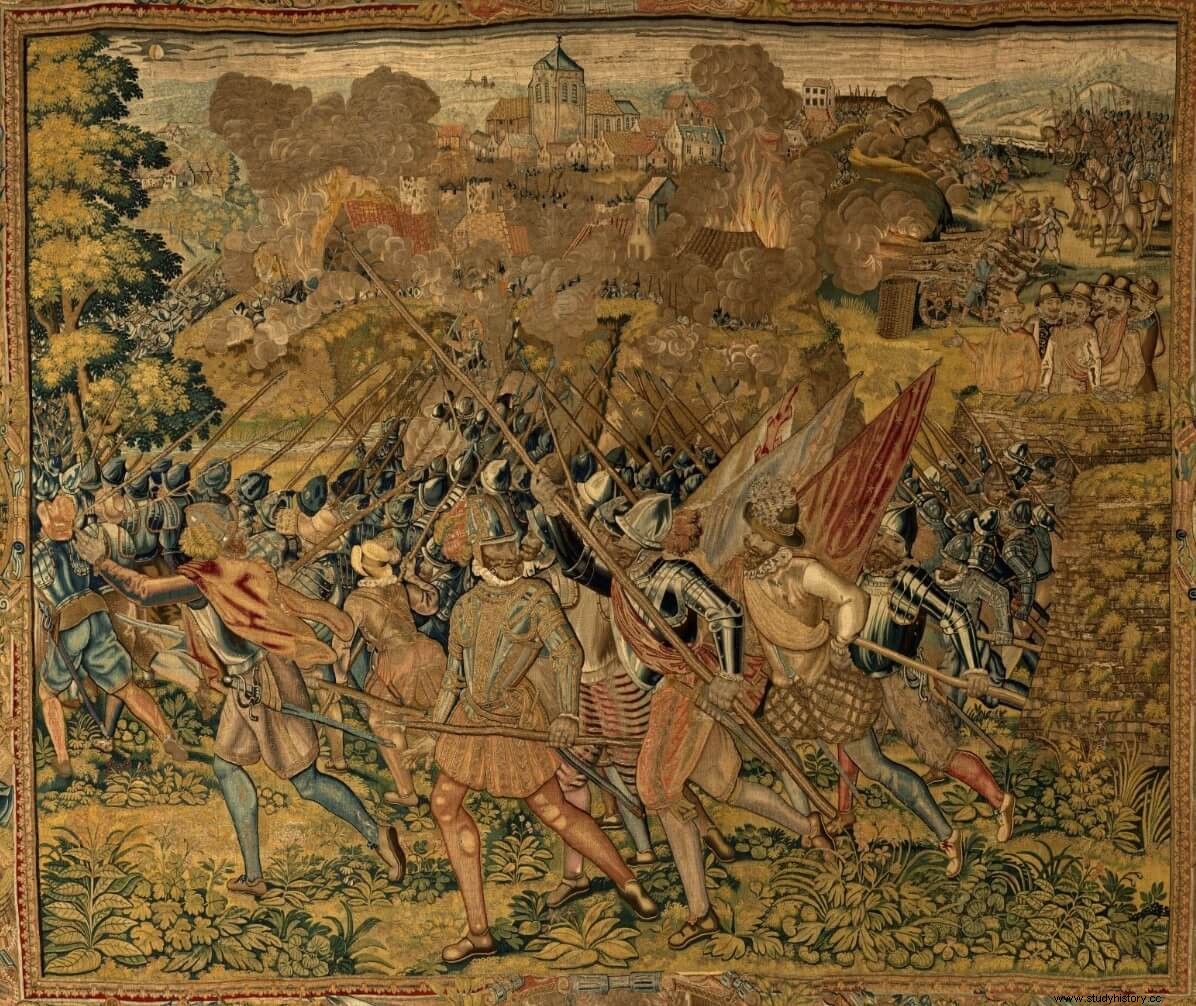
Sancho de Londoño, field marshal of the Tercio de Lombardy, exposes in his Speech on how to reduce military discipline to the best and oldest state , written in 1568, a very detailed description of the tactical importance of pikes and the optimal way to fight with them. A veteran of the Italian War and the War of the Schmalkaldic League, this captain shows that, in "a plain without groves or ditches, in such a place a square squadron of people must be formed, for which the two parts of the company have to carry pikes, because among ordinary people they are the strength of the squads, and there queens (as they say) of weapons”.[34] Londoño was in favor of using very long pikes, 26 hands long –5.94 m–, at least in the first rows of the squad, which, as we saw in the previous chapter, were the ones that really entered into combat with their weapons. The field master reasons the following:
Londoño makes a clear distinction between the pikemen in the front ranks and flanks of the squad, and those in the inner positions. The first were the corselets , well protected with steel armor, while the latter were the so-called “dry pikes”, who wore little or no armor and had a differentiated tactical function:“Unarmed pikemen are extremely necessary for many expeditions that take place, for which it is convenient to send them with expeditious arquebusiers, where cavalry cannot go, nor would coseletes arrive in time.”[36] Such missions include the pursuit of the vanquished enemy over terrain unsuitable for cavalry, and the assault on breaches in strongholds during sieges. Martín de Eguíluz, in his Military, speech and military rule [37]
In the first battles of the war, the Army of Flanders and the rebel forces used different tactical devices. The Duke of Alba's troops carried more firearms than pikes, so they formed squads that were wider than they were deep. Francisco de Valdés describes the device that the duke used in 1568 to confront William of Orange by the Meuse, although it did not come to a pitched clash:“he found that there were no more pikes in all three regiments than one thousand two hundred, and they all seemed that a squadron with a large front be formed, which, according to the number of pikes that there were, and keeping the due proportion, could not be given more front than sixty pikes and twenty deep.”[38] In contrast, the German lansquenets who made up the core of the orange forces carried many more pikes than firearms and formed their squads with more depth than front. As Bernardino de Mendoza pointed out:“the German nation has the habit of giving the squads much more background than painting.”[39] It is not that the first option was better, but that one or the other depended on the number of spades available. It was necessary to form a front wide enough to prevent the enemy squadron from outflanking their own, but there was no point in offering too long a front to enemy musketeers and arquebusiers.
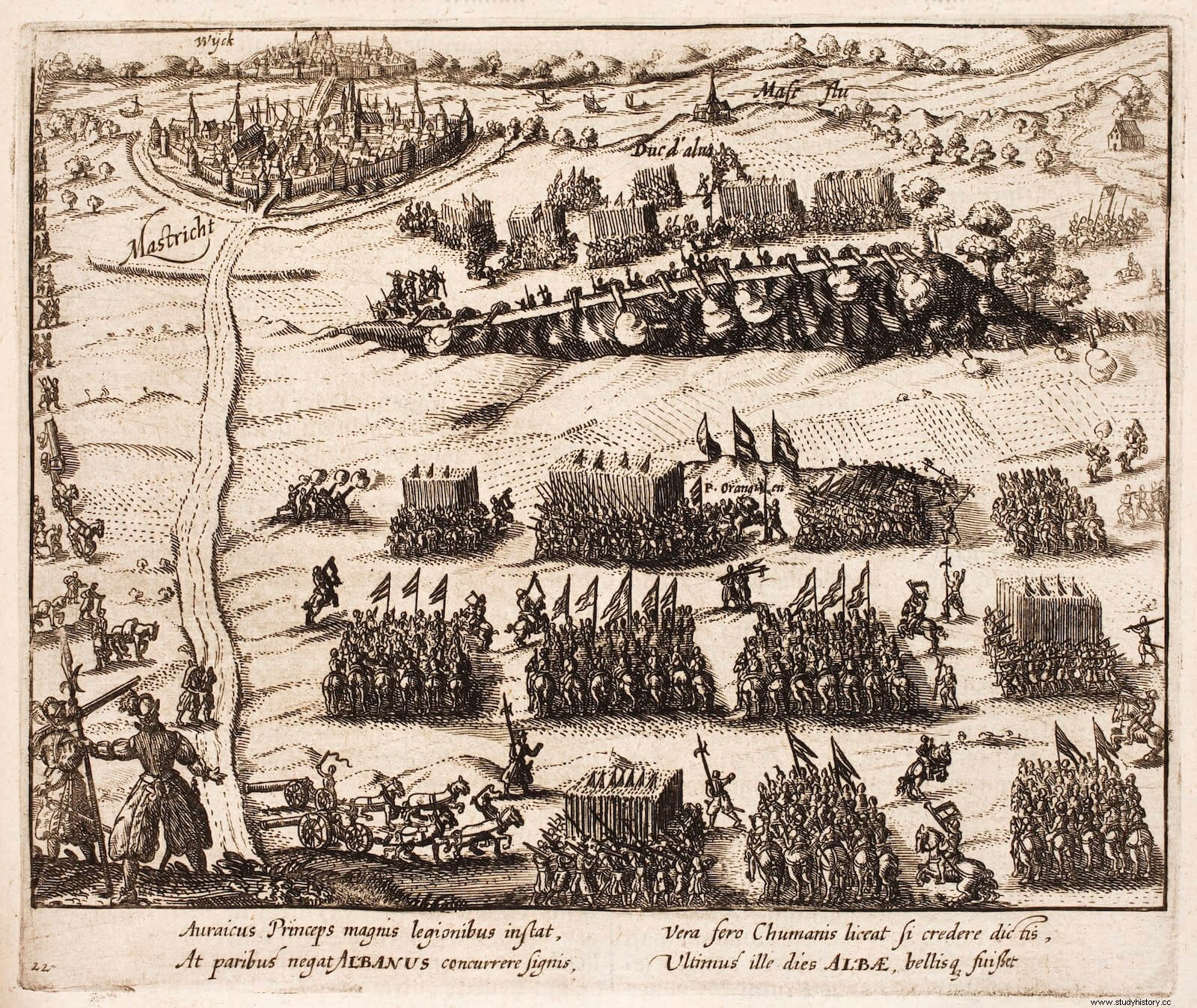
At Heiligerlee, according to the practice of the time Before the clash of pikes, there were skirmishes between the sleeves of arquebusiers of both armies, who marched to meet each other. The Spanish arquebusiers and musketeers advanced until they had the two large squadrons of Luis de Nassau's lansquenetes within their range, whom they reduced with their shots. The German pikes began to shake and collide with each other, which was called "ramming". Some chestguards of the Sardinian Tercio, in an act of flagrant indiscipline, then went on the attack. Bernardino de Mendoza describes it in detail:
The chestguards inadvertently wandered into a peat bog, where they were rammed and slaughtered by the largest of the Protestant squads. The entire Catholic army quickly disintegrated, and the commander himself, the Duke of Aremberg, fell in a desperate cavalry charge to try to salvage the situation. The Sardinian Tercio lost about four hundred and fifty soldiers and ten officers:three captains and seven lieutenants.
In Jemmingen things turned out very differently. This battle is famous, above all, because for the first time the great tactical utility of the musket became clear. , which the Duke of Alba had incorporated in small numbers into his infantry in 1567, before leaving the Italian army for Flanders. The best-known episode of the combat is the one in which Hernando de Toledo and Julián Romero, stationed with several hundred arquebusiers and musketeers on a dike of the Ems River to the left of the Orangist position, stopped the advance with their volleys, at that pass narrow, from two of the enemy squadrons:"Our musketeers and arquebusiers began to play at them furiously, shooting at them so often, that without daring to go forward, having walked about three hundred paces, they returned to their fort," wrote Mendoza.[41] ] The Catholic triumph, however, was decided with the general advance of the squadrons on the Orangist position once the musketry and musketry had softened them. This is how the chronicler Pedro Cornejo describes it:“The Spanish soldiers […] who, being old in the exercise of war and well disciplined, seldom lose the opportunity offered to them, seeing the squadron open and the pikes swirl, making a small prayer, according to the praiseworthy custom that they use in such trances, they attacked so superbly […] as I say, although they exceeded twelve thousand soldiers.”[42]
The firearm proved extremely useful against inexperienced troops, such as those formed by the rebels in Holland in 1572 to oppose the advance of the Army of Flanders and rescue Haarlem, besieged that December. In one of the rescue attempts there was a clash that illustrates both the inefficient use of the pike by the rebels and the way in which the arquebusiers could destroy a squad of infantry, which, as in the example described by Agrippa d'Aubigné in Courtras, involved first riddled the pikemen and then melee them with swords. The report of an anonymous Spanish officer explains the device that had formed the rebel army that arrived from Leiden:“they had their squad very well formed, which was very beautiful, because it was very well armed and garrisoned with its arquebus, and with its two sleeves drawn, and in a place that had a stream in front of them, they had placed their cavalry on the right hand, a little in the vanguard”.[43] Don Fadrique, son of the Duke of Alba, blocked the way for the rebels with a handful of arquebusiers and a troop of men-at-arms, who held off the enemies, commanded by Guillermo de La Marck, Lord of Lumey, until the Catholics received German reinforcements and went on the offensive:
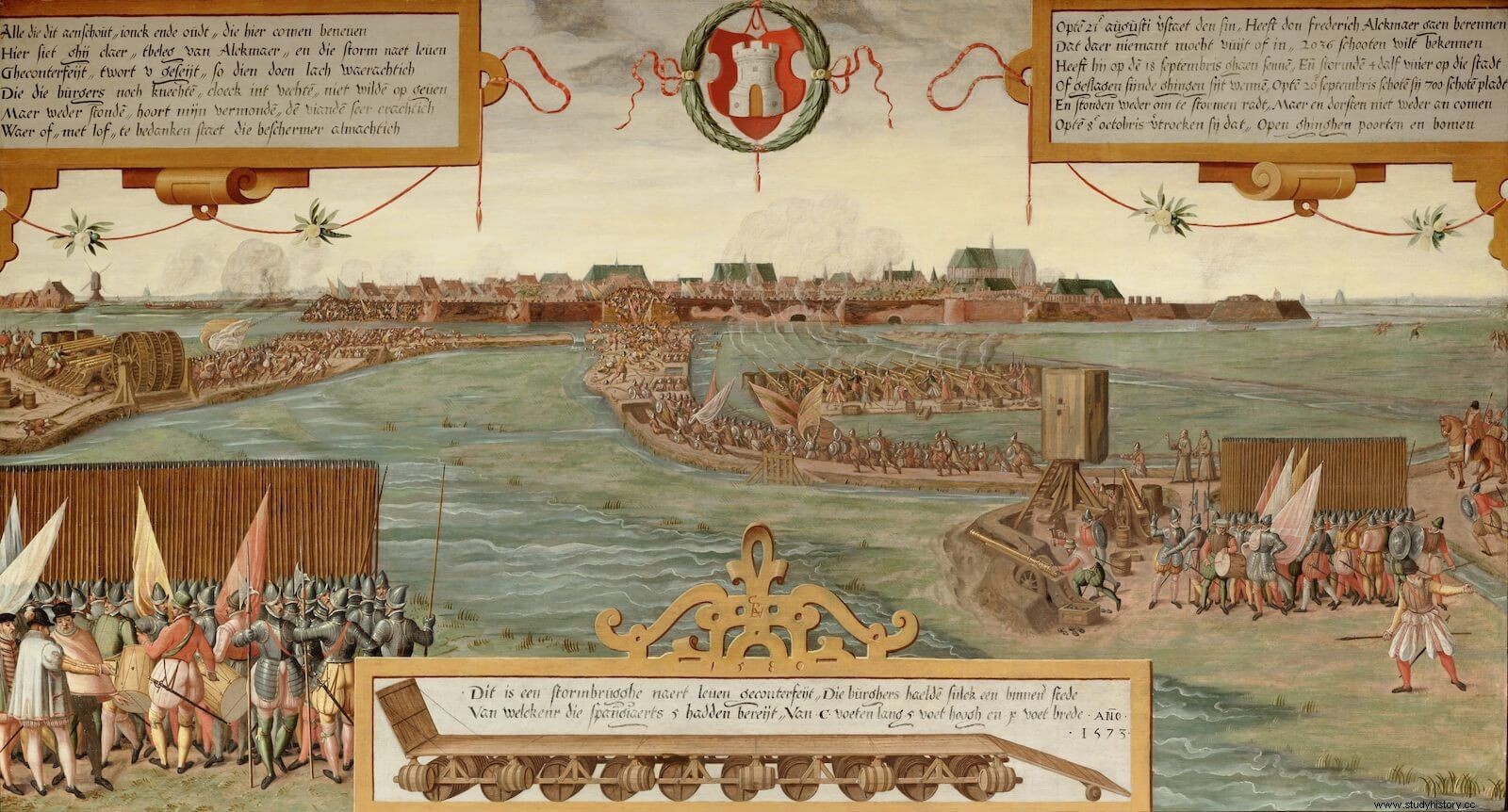
The overwhelming power of the Spanish squadrons , which the rebels suffered again in Mookerheide and Gembloux, induced in the rebel commanders – English and French professionals such as François de la Noue, John Norris, Philip von Hohenlohe-Neuenstein or Armand de Gontaut – a certain fear of confronting the Army of Flanders at open field. This fear only began to subside in 1586 as a result of the Battle of Batenburg Dyke, during the Siege of Grave, in which the rebels achieved a small victory in a fierce clash between the respective pike formations. Captain Alonso Vázquez wrote that:“The rebels were so proud of having measured their pikes with the Spanish ones, because until then, as I have already written, they had not dared on many occasions that they had offered themselves, if it was not behind the walls or strong trenches, who grew in confidence that they could go out with other more difficult companies.”[45]
The fact that pitched battles were rare, however, did not prevent troops from fighting in squads on countless occasions. It could well happen that an army, usually the Catholic, attacked the Protestant in a fortified camp with trenches, as happened at Rijmenan (1578), the Burgorant of Antwerp (1579) or Engelen (1587), or that it set up a large-scale ambush to a column of enemy troops with supply carts, with factions as notorious as that of Zutphen (1586). Also in the jacketed and hand strikes formed squads were kept in case the attack was discovered and it was necessary to cover the men involved. Lo mismo sucedía en los asedios como respuesta a la salida, por sorpresa, de los defensores. En estas circunstancias se solía formar “escuadrones volantes”, que no sumaban miles de hombres, sino unos pocos centenares. El galés Roger Williams describe la lucha delante de Middelburg, en 1572, entre las tropas rebeldes de las que formaba parte y los defensores católicos de la ciudad, que habían caído sobre sus posiciones:
En Zutphen , la lucha fue muy encarnizada. El convoy español estaba defendido por un escuadrón volante de seiscientos hombres de los tercios de Francisco de Bobadilla y Juan del Águila, que no solo frenaron el embate de la caballería inglesa, aunque esta logró romper las dos o tres hileras de vanguardia, sino que también se enfrentaron con un escuadrón de infantería inglesa y lo pusieron en desbandada con el concurso de los arcabuceros. Como cuenta Alonso Vázquez:
Las reformas de Mauricio de Nassau
Designado capitán general del Ejército de las Provincias Unidas en 1587, Mauricio de Nassau no tardó en convertirse en un referente para amigos y enemigos. Sin embargo, sus presuntas innovaciones deben ser sometidas a un riguroso escrutinio. No inventó el fuego por hileras, conocido ya en el siglo XV; tampoco es suya la idea de reducir el número de picas y aumentar el de arcabuces y mosquetes, y los escuadrones de gran frente ya los había puesto en práctica el Ejército de Flandes dos décadas antes. En todo caso, las reformas de Mauricio, lejos de superar el modelo español, lo que hicieron fue igualar al tercio la ineficaz infantería de las Provincias Unidas, deudora de las tropas de lansquenetes que habían formado los ejércitos rebeldes en los inicios de la revuelta. Aún así, es difícil atribuir sus éxitos militares a las novedades tácticas que introdujo, pues, como señaló D. J. B. Trim, a lo largo de su carrera evitó siempre las batallas campales y no libró más que una, la de Nieuwpoort (1600), lo que no permite extraer conclusiones sobre su habilidad táctica.[48]
La innovación de Nassau que equiparó la capacidad combativa de las tropas neerlandesas con las del Ejército de Flandes fue el constante adiestramiento de la tropa tanto a escala individual, en el manejo de sus armas, como a escala táctica, en las maniobras de formaciones. Del grado de complejidad del primer aspecto da fe el Wapenhandelingen van Roers, Musquetten ende Spiesen (1607) de Jacob de Gheyn II, una serie de grabados que recoge los movimientos que debían realizar los piqueros, arcabuceros y mosqueteros del Ejército de las Provincias Unidas. El manejo de la pica implicaba veintiún movimientos, el del arcabuz, cuarenta y dos, y el del mosquete, cuarenta y tres.[49] Aún en la década de 1590, los regimientos de infantería neerlandeses incluían una mínima cantidad de soldados armados con alabardas, espada y rodela, e incluso montantes, puesto que no fue hasta febrero de 1599 cuando entraron en vigor en las Provincias Unidas las primeras regulaciones que fijaban el armamento y el número de efectivos de la compañía de infantería.[50]
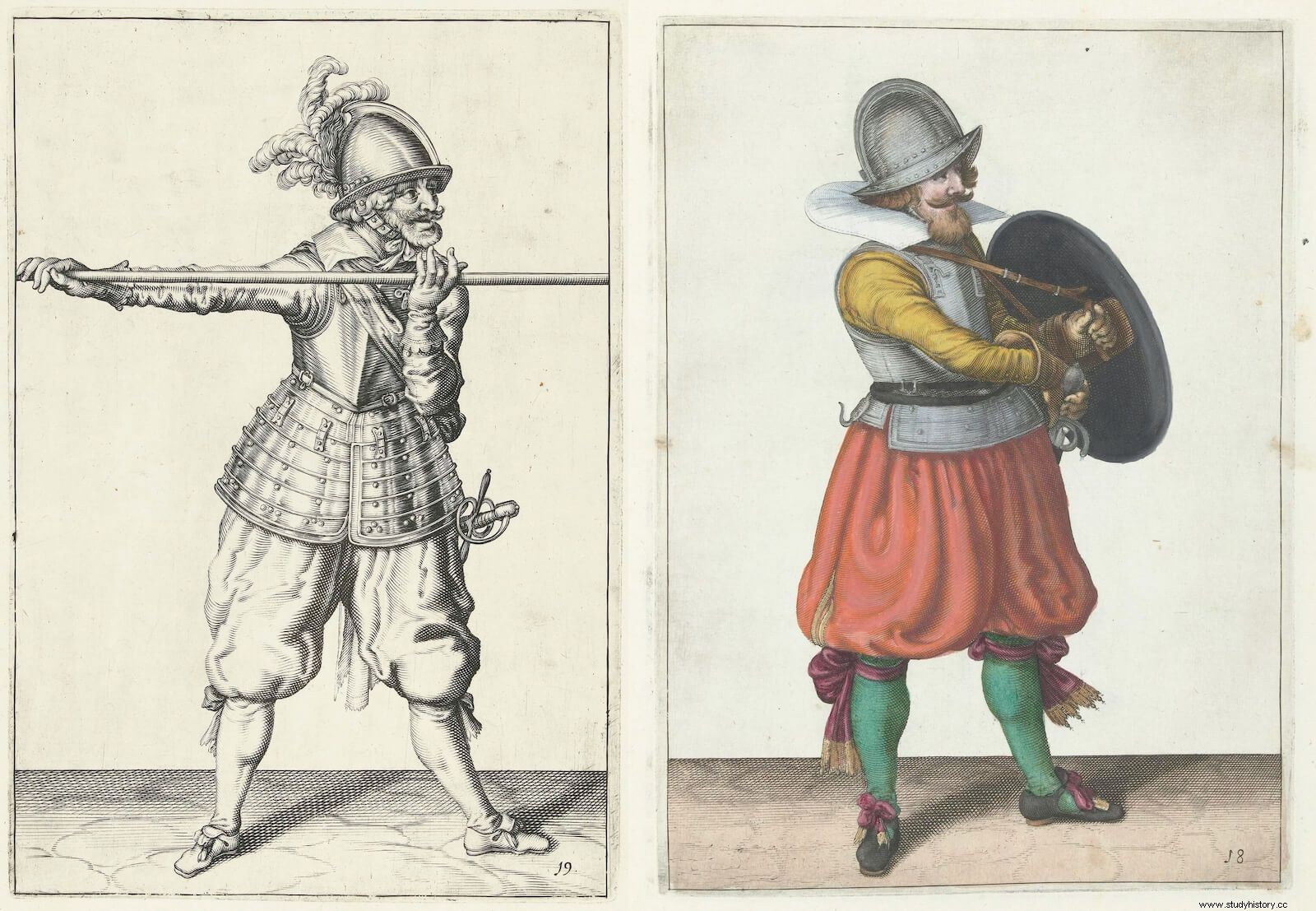
Mauricio, y sus mentores y colaboradores principales, Guillermo Luis de Nassau-Dietz y Juan Mauricio de Nassau-Siegen, llevaron a cabo múltiples experimentos tácticos , inspirados por teóricos militares griegos, romanos y bizantinos, en especial Eliano el Tácito y el emperador León VI el Sabio, que los influenciaron en la manera de maniobrar los escuadrones y sus subdivisiones tácticas.[51] En el plano armamentístico, sin embargo, no llevaron a cabo muchas innovaciones. Los grabados de Jacob de Gheyn muestran que los piqueros blandían la pica de forma similar a como explicitaba cuatro décadas atrás Sancho de Londoño. Sí se produjo un intento, en 1595, de encuadrar una mayor cantidad de rodeleros en las compañías, pero no fructificó ante la reticencia de los oficiales y los Estados Generales. Anthonie Duyck, funcionario del Consejo de Estado de Holanda agregado al ejército, describe el espléndido desempeño de las rodelas contra las picas en una serie de ejercicios:
La introducción en grandes cantidades de un arma que, por entonces, se utilizaba de modo limitado en los asaltos, para arremeter en las brechas con una protección a prueba de balas, estaba condenada de antemano al archivo a pesar de contar también con partidarios en el otro bando, en el que Diego de Álava y Viamont defendió su uso en El perfecto capitán instruido en la disciplina militar y nueva ciencia de la artillería (1590), inspirándose también en modelos romanos.[53] Aunque el resurgir de la rodela quedó aparcado, las teorías de Mauricio y sus colaboradores aparecen plasmadas en un manual, De Nassavsche Wapen-Handelinge van Schilt, Spies, Rappier end Targe (1618), ilustrado por Adam van Breen, que muestra no solo infantes armados con espada y rodela, sino también piqueros equipados con escudos –una excentricidad mucho menor que la pretensión del inglés William Neade, en 1625, de crear una infantería mixta de piqueros con arcos largos–.
A pesar de la tendencia a considerar el modelo de Mauricio como fundado eminentemente en las armas de fuego, la única batalla campal del periodo, la de Nieuwpoort (1600) , se caracterizó por un duro y prolongado combate cuerpo a cuerpo entre las picas de los respectivos escuadrones, que relatan oficiales de ambos bandos. Antonio Carnero, contador del Ejército de Flandes, escribió que “la infantería, que había acometido de frente y ganado la primera duna, peleaba valerosamente por ganar la grande, donde estaban plantadas las cinco piezas de artillería […]; se peló con gran porfía, y llegaron a hacerlo pica a pica más de una hora con señal de victoria y gran esperanza de ella”.[54] Luis Gunther de Nassau, que comandaba la caballería de las Provincias Unidas, señaló:“la infantería llegaba de continuo a las manos a golpes de pica y de espada, y tan buen punto unos llevaban lo peor como lo hacían los otros […]. El cruel combate que se libró fue increíble, particularmente entre la infantería, que pasó dos horas sin cesar a las manos, pica contra pica, sin haber un solo terrón de la duna que no se tomase y retomase al asalto, en especial entre los ingleses, los franceses y los valones».[55]
A principios del siglo XVII, en conclusión, la pica seguía siendo la reina de las armas , el pilar de los ejércitos en los días de batalla y en multitud de ocasiones distintas, pues se trataba, tal y como hemos visto, de un arma versátil y eficaz tanto contra la caballería como frente a la infantería. El arte de la guerra experimentó una transformación ostensible en la segunda mitad del siglo XVI, pero no tanto a escala táctica como estratégica, organizativa y logística. En la Guerra de los Treinta Años (1618-1648) se introdujeron las innovaciones que consagrarían de manera definitiva el predomino del arma de fuego.
Bibliography
- Albi, J. (2017):De Pavía a Rocroi. Los tercios españoles . Madrid:Awake Ferro Editions.
- Bru, J.; Claramunt, À. (2020):Los tercios . Madrid:Awake Ferro Editions.
- Delbrück, H. (1990):The Dawn of Modern Warfare . Lincoln, London:University of Nebraska Press.
- Hoeven, M. van der (1997):Exercise of Arms:Warfare in the Netherlands, 1568-1648 . Leiden:BRILL.
- Nimwegen O. van (2010):The Dutch Army and the Military Revolutions, 1588-1688 . Woolbridge:Boydell Press.
- Parker, G. (2000):El ejército de Flandes y el camino español, 1567-1659:la logística de la victoria y derrota de España en las guerras de los Países Bajos . Madrid:Alianza Editorial.
- Quatrefages, R. (1983):Los Tercios . Madrid:Servicio de Publicaciones del Estado Mayor del Ejército.
Notes
[1] Mendoza, B. (1592):Comentarios de don Bernardino de Mendoça de lo sucedido en las guerras de los Payses Baxos:desde el año de 1567 hasta el de 1577 . Madrid:Pedro Madrigal, p. 20.
[2] D’Aubigné, T. A. (1873):Œuvres complètes de Théodore Agrippa d’Aubigné . Paris:Alphons Lemerre, pp. 405-406
[3] Le Frère de Laval, J. (1575):La vraye et entière histoire des troubles et guerres civiles:avenuës de nostre temps, pour le faict de la religion, tant en France, Allemaigne que Pays Bas . Paris:Marc Locqueneulx, p. 155.
[4] Carta sin firma sobre la batalla de San Quintín, París, 13 de agosto de 1557, en Lemaire, E.; et. al. (1896):La guerre de 1557 en Picardie . Saint-Quentin:Charles Poette, p. 266.
[5] Ávila y Zúñiga, L. de (1550):Comentario del ilustre señor D. Luis de Avila y Zuñiga, comendador mayor de Alcantara, de la guerra de Alemania hecha por Carlos V, maximo emperador romano, rey de España, en el año de MDXLVI y MDXLVII . Anvers:Juan Steelsio, p. 87.
[6] Núñez Alba, D.; Fabié, A. M. (ed.) (1890):Diálogos de la vida del soldado de Diego Núñez Alba . Madrid:Librería de los Bibliófilos, pp. 206-207.
[7] Mendoza, B. de (1596):Theorica y practica de guerra . Anveres:Emprenta Plantiniana, p. 56.
[8] Noue, F. de la (1588):Discours politiques et militaires . Paris:François Forest, p. 312.
[9] Saulx-Tavannes, J. de (1838):Mémoires de tres-noble et tres illustre Gaspard de Saulx, seigneur de Tavannes , en Mémoires pour servir a l’Histoire de France , VIII. Paris:Adolphe Everat, p. 267.
[10] Taylor, F. L. (2010):The Art of War in Italy 1494-1529 . Cambridge:Cambridge University Press, p. 61.
[11] Saulx-Tavannes, op. cit ., p. 267.
[12] Contarini, A. (1572):Relazione di Francia , en Albèri, E. (ed) (1860):Le relazioni degli ambasciatori veneti al Senato raccolte, annotate ed edite da Eugenio Albèri , IV. Firenze:Socièta Editrice Fiorentina, p. 233.
[13] Wood, J. B. (2002):The King’s Army:Warfare, Soldiers and Society During the Wars of Religion in France, 1562-76 . Cambridge:Cambridge University Press, pp. 132-133.
[14] Wood, op. cit . p. 111.
[15] De la Noue, op. cit ., pp. 267-268.
[16] Gontaunt, A. de (barón de Biron) (1936):The Letters and Documents of Armand de Gontaut:Baron de Biron, Marshal of France (1524-1592) . Berkeley:University of California Press, p. 63.
[17] Tavannes, op. cit ., p. 84
[18] De la Noue, op. cit ., p. 315.
[19] Biron, op. cit ., p. 63.
[20] De Coynart (1894):L’année 1562 et la Bataille de Dreux . Paris:Firmin-Didot et cie., p. 27.
[21] Mergey, J. de; Camusat, N. (ed.) (1788):Mémoires du sieur Jean de Mergey, gentilhomme champenois , en Collection Universelle des mémoires particuliers, relatives a l’Histoire de France , XLI. Paris:Rue et Hôtel Serpente, p. 63.
[22] Lorena, F. de (duque de Guisa) (1562):Discours de la bataille de Dreux dicté par feu , en Lafaist, L. (ed.) (1835):Archives curieuses de l’histoire de France . Paris:Beauvais, p. 111.
[23] Lorena, op. cit ., p. 112.
[24] Castelnau, M. de (señor de la Mauvissière) (1823):Mémoires de Messire Michel de Castelnau . Paris:Foucault, pp. 244-245.
[25] Le Frère de Laval, J. (1583):La vraye et entiere histoire des trovbles et gverres civiles aduenues de nostre temps, tant en France qu’en Flandres &pays circonuoisins, depuis l’an mil cinq cens soixante, iusques à present , I. Paris:Guillaume de la Nouë, p. 188.
[26] Carta de Pedro de Ayala a don Francisco de Cisneros, Dreux, 22 de diciembre de 1562, en Lafaist, L. (ed.) (1835):Archives curieuses de l’histoire de France . Paris:Beauvais, p. 87-88.
[27] Ayala, op. cit ., pp. 88-89.
[28] Oman, C. (1937):A History of the Art of War in the Sixteenth Century . London:Methuen &Co, p. 466.
[29] Tavannes, op. cit ., p. 217.
[30] D’Aubigné, A. (1616):L’histoire universelle du sieur d’Aubigné . Maille:Jean Moussat, p. 53.
[31] Williams, R. (1618):The actions of the Lowe Countries . London:Humfrey Lownes, pp. 89-90.
[32] Calvet d’Estrella, J. C. (1552):El felicísimo viaje del muy alto y muy poderoso príncipe don Phelippe desde España a sus tierras de la baja Alemania . Anvers:Martin Nuncio, p. 28.
[33] Calvet, op. cit ., pp. 28-29.
[34] Londoño, S. de (1589):Discurso sobre la forma de reduzir la disciplina militar à mejor y antiguo estado . Bruselas:Roger Velpuis, p. 9
[35] Londoño, op. cit ., p. 9
[36] Londoño, op. cit ., p. 11.
[37] Eguiluz, M. de (1592):Milicia, discurso, y regla militar del capitan Martin de Eguiluz . Madrid:Luis Sáchez, p. 96.
[38] Valdés, F. de (1589):Espejo y deceplina militar en el qual se trata del officio del Sargento Mayor. Bruselas:Roger Velpius, p. 14.
[39] Mendoza, B. (1592):Comentarios de don Bernardino de Mendoça de lo sucedido en las guerras de los Payses Baxos:desde el año de 1567 hasta el de 1577 . Madrid:Pedro Madrigal, p. 48.
[40] Op. cit. , p. 48.
[41] Op. cit. , p. 69.
[42] Cornejo, P. (1580):Origen de la civil disension de Flandes . Turín:herederos de Bebilaqua, pp. 51-52.
[43] Anónimo (1572):Relación de lo que se ha hecho después que se tomó Malinas con el ejército que guía el Sr. D. Fadrique en Flandes, para entrar en Harlem , en Sancho Rayón, J.; Zabalburu, F. de (eds.) (1880):Colección de Documentos inéditos para la Historia de España , LXXV. Madrid:Miguel Ginesta, pp. 148-149.
[44] Ídem.
[45] Vázquez, A. (1610):Los sucesos de Flandes y Francia del tiempo de Alexandro Farnese, II, en Sancho Rayón, J.; Zabalburu, F. de (eds.) (1879):Colección de Documentos inéditos para la Historia de España , LXXIII. Madrid:Miguel Ginesta, p. 67.
[46] Williams, op. cit ., pp. 59-60.
[47] Vázquez, op. cit ., p. 219.
[48] Trim, D. J. B. (2013):Maurice of Nassau , en Messenger, C. (ed.):Reader’s Guide to Military History . London:Routledge, p. 347.
[49] Delbrück, H. (1990):The Dawn of Modern Warfare . Lincoln, London:University of Nebraska Press, p. 170.
[50] Nimwegen O. van (2010):The Dutch Army and the Military Revolutions, 1588-1688 . Woolbridge:Boydell Press, p. 87, 91.
[51] Hoeven, M. van der (1997):Exercise of Arms:Warfare in the Netherlands, 1568-1648 . Leiden:BRILL, p. 79.
[52] Duyck, A.; Mulder, L. (ed.) (1862):Journaal van Anthonis Duyck (1591-1602) , I. ‘S-Gravenhague, Arnhem:Martinus Nijhoff, D. A. Thieme, p. 635.
[53] Álava y Viamont, D. de (1590):El perfeto capitan, instruido en la disciplina militar, y nueua ciencia de la artilleria . Madrid:Pedro Madrigal, p. 136.
[54] Carnero, A. (1625):Historia de las guerras civiles que ha avido en los estados de Flandes des del año 1559 hasta el de 1609 y las causas de la rebelion de dichos estados . Bruselas:Juan de Meerbeque, p. 475.
[55] Luis Günther de Nassau a Juan de Nassau, relación de la batalla de Nieuwpoort, en Prinsterer, G. G. van (1858):Archives ou correspondance inédite de la maison Orange-Nassau , II (1600-1625). Utrecht:Kemink et fils, p. 31 y 33.
